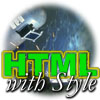The Million Dollar Question
 The Million Dollar Question
The Million Dollar Question
Having seen what the specification is and what it can do for us, it is necessary to assume that we must author HTML documents according to the specification. Here is why:
- Our documents are proper HTML. Their syntax can be checked easily using a validator and we can be sure programs such as editors, search engines, converters and browsers can process them correctly.
- We can use SGML programs to do useful things such as validate our documents, convert them into other formats (such as more printer- friendly formats), process large amounts of documents at one time (to do things like include identical portions of a document in many different documents) and so on.
- We know that our documents will work far into the future without any changes on our behalf. Since they conform to an existing and well- defined specification, programs that conform to this specification will always understand our documents.
- Our documents are clearly labelled as conforming to a certain
specification. Programs that do not fully understand this specification
can warn users that they cannot process our documents, while programs
that do understand the specification can be sure that the document will
have the syntax they expect.
The issue of extra browser functionality is more or less moot in this day and age. The specification for HTML 4.0 is advanced enough to offer all the capabilities that browsers offer. The problem is that the browsers don't support all of the things in the specification. The trick is achieving the desired effect in a way that both satisfies the specification (and hence gives all the advantages noted above) and takes advantage of the features in the most popular browsers while working around their bugs. How do you do that? That, as they say, is the million dollar question.
My job is to teach you how to do that. I'm sorry I can't give you the million dollars too.
All of the elements we have seen so far are part of the "strict" HTML 4.0 specification. This is the part of the specification we will cover first in these tutorials. Some of the attributes to these elements are deprecated (such as the color attributes to the
BODYelement, which were mentioned but not explained in Tutorial 3). This the main reason I have not explained these attributes yet: I had to tell you they are deprecated and why.Once you know how to write documents in HTML 4.0 Strict reasonably well, I'll go through some of the more important deprecated elements that are in wide use and show you how they are used. Most of these elements are used to alter the presentation of an HTML document on the screen. This functionality does not belong to HTML, and today a technology called Cascading Style Sheets (CSS) is used to define the look of HTML documents. This is what we'll cover next. There are other technologies that relate to HTML and CSS and are used in Web pages, such as Java, JavaScript, graphics, VRML and more. These technologies are not part of HTML or CSS, but they are closely related to it. We will go through the ways they work together and how best to use them with HTML and CSS.
Having said all that, let's look at an example of how Explorer and Navigator make a mess of HTML.
Produced by Stephanos Piperoglou
All Rights Reserved. Legal Notices.
URL: https://www.webreference.com/html/tutorial4/5.html
Created: July 12, 1998
Revised: July 12, 1998





 Find a programming school near you
Find a programming school near you